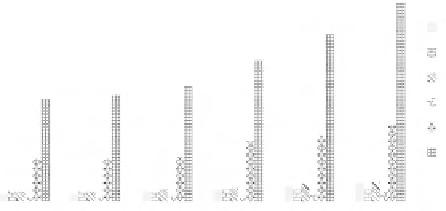Environmental Engineering Reference
In-Depth Information
12
crude oil
oil products
iron ore
coal
grain
other goods
complete
10
8
6
4
2
0
2000
2002
2004
2006
2008
2010
year
Fig. 3.8
Development of the world Total Seaborne Trade (TST)
stern
smokestack or
funnel
superstructure
anchor
deck
bulbous bow
bow
portside
propeller and rudder
Fig. 3.9
Main structural elements of a merchant vessel
3.3.1 Optimization of Takeoff Mass
Fuel makes up a high proportion (near 50%) of the takeoff mass of airplanes. The
B767-200/200ER, a modern long-range, wide body, twin aisle airplane has the
maximum takeoff weight of 179,170 kg (395,070 lb), the empty weight of
86,000 kg (189,630 lb), and the maximum freight load of 30,000 kg (66,150 lb).
Tanks contain approximately 73,000 kg (160,965 lb) of fuel which allows for
flight time of 15-16 h, i.e., 12,500-13,333 km (6,749-7,199 nmi). Safety regu-
lations require additional fuel of 7,000 kg (15,435 kg) to make it possible to fly an
extra time of 1.5 h. This equals to the distance of 1,200-1,300 km (648-702 nmi)
or the weight of 70-75 passengers [
42
].
3.3.2 Use of New Construction Materials
Aluminum has been the first new material used in construction and its application
resulted in lower weight and decreased operational and maintenance costs by 50%.























































































Search WWH ::

Custom Search